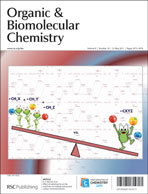Collision induced dissociation (CID) of sodiated peptide derivatives containing a nitrate ester functionality was used to regiospecifically generate three isomeric radicals of the model peptide Bz-Ala-Gly-OMe corresponding to radicals formed at: Cα of the alanine residue [4+Na]+; Cα of the glycine residue [5+Na]+; and the side chain of alanine [6+Na]+. The ion-molecule reactions of these peptide radicals were examined to model oxidative damage to peptides and to probe whether the radical sites maintain their integrity or whether they isomerise via intramolecular hydrogen atom transfer (HAT). Only [6+Na]+ is reactive towards O2, forming the peroxyl radical [7+Na]+, which loses O2, HO˙ and HO2˙ under CID. The radical ion [7 + Na]+ abstracts a hydrogen atom from 4-fluorothiophenol to form the hydroperoxide [8+Na]+, which upon CID fragments via the combined loss of HO˙ and CH2O. In contrast, all three of the isomeric sodiated radicals react with NO˙ and NO2˙ to form adducts. CID of the NO adducts only regenerates the radicals viaNO˙ loss, thus providing no structural information. In contrast, CID of the NO2 adducts gives rise to a range of product ions and the spectra are different for each of the three adducts, suggesting that the isomeric radicals [4+Na]+, [5+Na]+ and [6+Na]+ are produced as discrete species. Finally, CID of the NO2 adducts was used to probe the rearrangement of the radicals [4+Na]+, [5+Na]+ and [6+Na]+ prior to their reaction with NO2˙: [6 + Na]+ rearranges to a mixture of [4+Na]+ and [5+Na]+ while [5+Na]+ rearranges to [4+Na]+.

You have access to this article
 Please wait while we load your content...
Something went wrong. Try again?
Please wait while we load your content...
Something went wrong. Try again?


 Please wait while we load your content...
Please wait while we load your content...